nn
n
n Today is Mother’s Day (I do hope you didn’tnforget), also known in the past as Mothering Sunday. It is the middle Sunday innLent, called Dominica Refectionis, the Sunday of Refreshment, by legendnthe day on which Christ fed the five thousand, when parishioners would visitntheir cathedral, or ‘Mother church’, taking gifts of denarii quadrageminales,nor Lenten pennies. The practice died out in the mid-thirteenth century but thencommon custom continued as servants and apprentices were given time away fromntheir duties in order to visit their natural mothers. They would either receivenor give gifts of fine bread or cake, an especial treat for those who usuallynate coarser fare, which had the name simnel, coming from the Latin similan– fine flour, through the Old French simenel (semolinanderives from the same root, as does the German word for a roll – semmel).
n
n
n
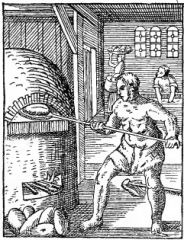 |
| A Bakery |
n
n
n
nIn the past, there were four types of bread, the very best of which was madenwith the finest flour and this was simnel. Next down the scale and the finest breadneaten ordinarily was called wastel, followed by cocket, andnfinally, of poorest quality, was bread of treet; simnel and wastel wouldnbe made with wheat flour, the ordinary bread was made with barley, with thenpeasants bread made from rye, oats and beans. The English simnel was the purestnwhite bread, as in the Book of Battle Abbey,
n
n
n
n“Panem regire mensrenapsum, qui simenel vulgo vocatur.”n
n(Bread fit for the royal table, which isncommonly called simenel.)n
n
n
nLegislation on the quality and weight of loavesncame early to English law and there are numerous records of bakers beingnpunished for selling ‘light’, or underweight, bread – this example is fromnRobert Fabyan’s Chronicle of 1268,
n
n
n
n“In processe of tyme after, thensayde syr Hughe, with others, came to Guylde hall, & kepte his courte andnplees there withoute all ordre of lawe, and contrary to the lybertyes of thencytie, and there punysshed the bakers for lacke of syze by the tuberell, wherenbefore tymes they were punysshed by the pyllery, and orderynge many thynges atnhis wyll, more than by any good ordre of lawe.”n
n
n
nSpecific weights werendesignated to each loaf, according to cost, from eighteen penny loaves down tontwo penny loaves, and just to be on the safe side, when it came down to pennynloaves, bakers would throw in an extra loaf for every twelve loaves bought,nwhich is why we call thirteen of anything ‘a baker’s dozen’ (when itncame to half-penny loaves, two extras would be given – Grose, in his Dictionarynof the Vulgar Tongue, defines Baker’s Dozen as
n
n
n
n“BAKER’S DOZEN,nfourteen-, that number of rolls being allowed to purchasers of a dozen.”n
n
n
n
n
 |
| Another Bakery |
n
n
n
nRobert Herrick, in A Ceremonie at Glocester wrote,
n
n
n
n“Ile to thee anSimnell bring,n
n‘Gainst thou go’st a mothering,n
nSo that, when she blesseth thee,n
nHalf that blessing thou’lt give me.”n
n
n
nOver the years, the simnel breadnbecame more elaborate as further ingredients were added and it metamorphosedninto a simnel cake, which is delicacy still enjoyed particularly in the Northnof England.
n
n
n
n
n
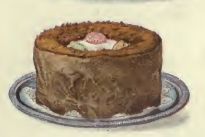 |
| Simnel Cake – from Mrs Beeton Book of Household Management – 1907 ed. |
n
n
n
nOne apocryphal story says that an old couple, Simon and Nell, setnto make a treat for their children, Nell making an unleaven crust which Simnfilled with the remains of the Christmas pudding. He said that the resultnshould be boiled, as it was a pudding, but Nell said it needed to be baked, asnit was a pie, so they compromised and cooked it both ways, and as it was sondelicious it was named for its creators, Sim and Nell.
n
n
n
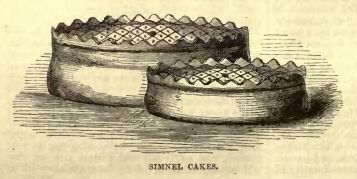 |
| Simnel Cakes |
n
n
n
nThere were regionalnvariations – at Shrewsbury, it took the form of a Warden pie (i.e. made fromnWarden pears), with a very thick crust flavoured with saffron, at Devices, thenpie was star-shaped, made with saffron, currants, spices, candied peels andnmade without the crust, whilst at Bury, the cake was made with dried fruits andnnuts and was more like a biscuit than a cake. Today, Simnel Cake is a two-layernfruitcake with marzipan in the centre and on the top, decorated with a candlen(to represent Christ) and eleven marzipan balls (representing the apostlesnminus Judas).
n
n
n
nSimnel Cake was accompanied in Lancashire with Bragget Ale, a namenthat comes from the Celtic bracata and the Welsh bragawd, oldnnames for mead, and has links to the old Scots Bragwort, another drink madenfrom honey; Bragget Ale in later days was a spicy, mulled beer, famously madenaround Leigh, and this practice has echoes of Shakespeare’s phrase ‘cakesnand ale.’
n
n
n
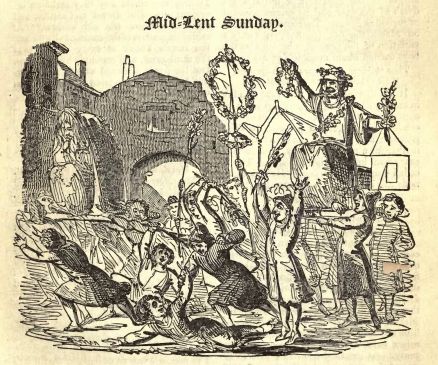 |
| Mid-Lent Sunday |
n
n
n
nIn some places, there were other variations – figs were eaten asna memory of Jesus coming down into Jerusalem from Bethany, when he had a tastento eat figs, and fig cakes were baked, which in Lancashire were callednFag-Pies, made from figs, spices and treacle on mid-lent Sunday in Blackburnnand Clitheroe, and on the following Sunday in Burnley. A local rhyme says,
n
n
n
n“Methodiesnswears, Dippers [i.e.Baptists] lies,n
nAnd Church-folk eats all th’nfag-pies.”n
n
n
n
n
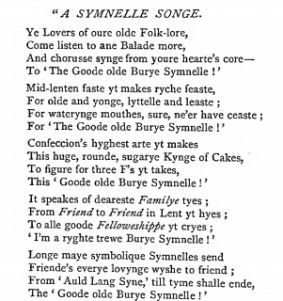 |
| A Symnelle Songe |
n
n
n
nYet another name for Mothering Sunday, its name coming fromnanother food, is Furmety Sunday, furmety or frumenty being whole grainsnof cracked wheat that are boiled in water, then added to milk, spices, raisins,nsugar and boiled again and sometimes almonds, eggs or saffron are also addedn(together with a healthy slug of spirits – brandy, rum or whisky); Frumentyncomes from the Latin frumentum – ‘grain’. Frumenty was often served withnmeat, particularly venison, and was also a Christmas Day favourite.
nnn
n
nnn
n
n
n



















